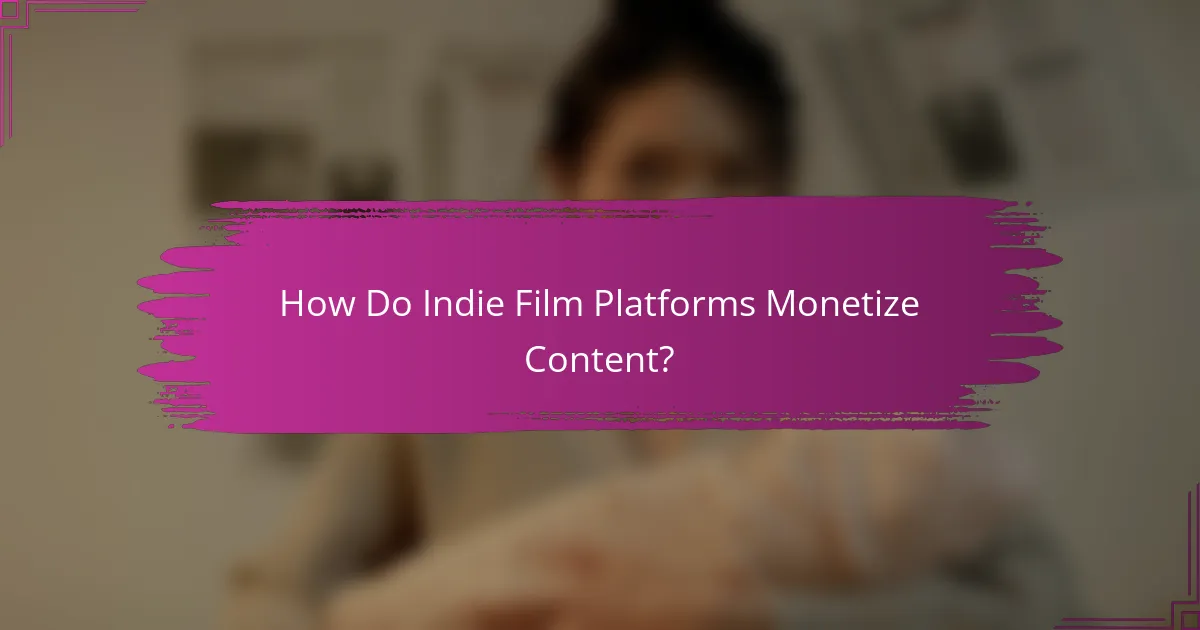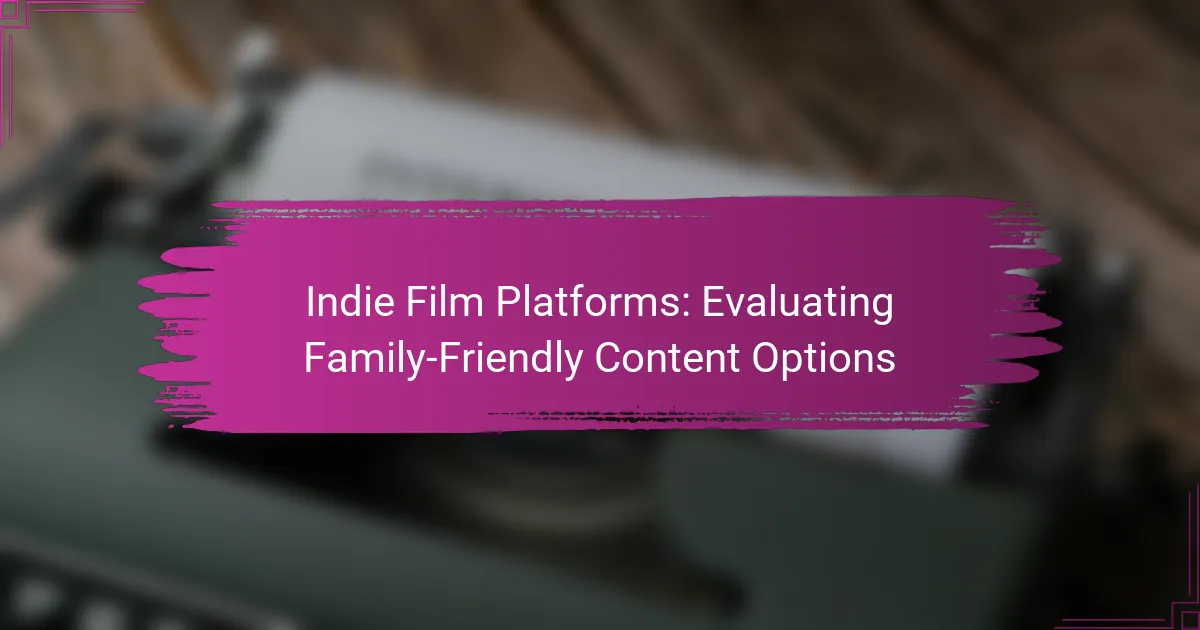Indie film platforms have become essential for filmmakers seeking to showcase their work and connect with audiences. Offering a diverse array of content, including feature films, short films, and documentaries, these platforms cater to various artistic expressions and viewer preferences. With different monetization strategies such as subscriptions and ad-supported streaming, they present unique opportunities and challenges for creators and consumers alike.

What Are the Leading Indie Film Platforms?
The leading indie film platforms provide filmmakers with opportunities to showcase their work and reach audiences. These platforms vary in terms of submission processes, audience engagement, and monetization options.
Vimeo
Vimeo is a popular platform for indie filmmakers, known for its high-quality video playback and creative community. Filmmakers can upload their films for free or choose a paid subscription for additional features like advanced analytics and customization options.
Consider using Vimeo’s On Demand feature, which allows filmmakers to sell their films directly to viewers. This can be a great way to retain more revenue compared to traditional distribution methods.
FilmFreeway
FilmFreeway is primarily a submission platform that connects filmmakers with film festivals. It simplifies the process of submitting films to multiple festivals, making it easier for indie filmmakers to gain exposure.
When using FilmFreeway, ensure your film meets the specific requirements of each festival. Keep track of deadlines and consider entering festivals that align with your film’s genre and themes for better chances of acceptance.
IndieFlix
IndieFlix is a streaming service dedicated to independent films, offering a subscription model for viewers. It focuses on showcasing diverse voices and unique storytelling, making it an appealing platform for indie filmmakers.
Filmmakers can submit their work for consideration, and if accepted, their films can reach a global audience. Be prepared for a revenue-sharing model, where filmmakers earn a percentage based on views.
Amazon Prime Video
Amazon Prime Video allows indie filmmakers to distribute their films to a vast audience through its Direct Video Upload program. This platform offers a familiar interface for viewers and the potential for significant exposure.
Filmmakers should consider the competitive nature of Amazon’s catalog and focus on marketing their films effectively. Utilizing Amazon’s promotional tools can help increase visibility and drive sales.
Netflix
Netflix is one of the largest streaming platforms globally, providing indie filmmakers with a prestigious avenue for distribution. However, getting a film on Netflix typically involves working with established distributors or agents.
Filmmakers should focus on creating high-quality content that stands out, as Netflix prioritizes unique and engaging stories. Networking within the industry can help filmmakers connect with the right people to pitch their projects effectively.

What Types of Content Do Indie Film Platforms Offer?
Indie film platforms provide a diverse range of content, catering to various audience preferences and artistic expressions. These platforms typically feature feature films, short films, documentaries, and web series, each offering unique storytelling formats and styles.
Feature Films
Feature films on indie platforms usually run for 60 minutes or longer, showcasing a complete narrative arc. They often explore niche genres or unconventional themes that mainstream cinema may overlook. Independent filmmakers can distribute their work directly to audiences, bypassing traditional studio systems.
Examples of popular indie feature films include “Moonlight” and “Lady Bird,” which gained critical acclaim and commercial success. These films often rely on festival circuits for initial exposure before reaching wider audiences through streaming services.
Short Films
Short films are typically under 40 minutes and serve as a platform for emerging filmmakers to showcase their creativity. They can be standalone stories or part of a larger anthology, often focusing on experimental narratives or innovative techniques. Indie platforms frequently host collections of short films, making it easy for viewers to discover new talent.
Many short films have gained recognition through festivals like Sundance or Cannes, where they can attract attention from producers and distributors. This format is ideal for filmmakers looking to make a statement without the commitment of a full-length feature.
Documentaries
Documentaries on indie platforms cover a wide array of topics, from social issues to personal stories. They often aim to inform or provoke thought, providing insights into real-world events and experiences. Independent documentaries can be more flexible in terms of length, ranging from short pieces to full-length features.
Notable indie documentaries include “13th” and “Won’t You Be My Neighbor?” which have sparked conversations around critical societal issues. These films often find their audience through targeted marketing and social media outreach, enhancing their impact.
Web Series
Web series are episodic content designed for online viewing, typically consisting of multiple short episodes. They allow filmmakers to explore longer narratives over time, engaging audiences with character development and plot twists. Indie platforms often feature web series that cater to specific interests or demographics.
Examples include series like “High Maintenance,” which started as a web series before transitioning to television. The format allows for experimentation with storytelling styles and can be a cost-effective way for creators to reach viewers directly.

How Do Indie Film Platforms Monetize Content?
Indie film platforms monetize content through various strategies that cater to different audience preferences and revenue models. These methods include subscription services, ad-supported streaming, and pay-per-view options, each offering unique benefits and challenges for both creators and consumers.
Subscription Models
Subscription models charge users a recurring fee for access to a library of films and content. This approach provides a steady revenue stream for platforms, allowing them to invest in new indie projects. Commonly, subscriptions range from around $5 to $15 per month, depending on the platform’s content quality and exclusivity.
Platforms like Netflix and Hulu have popularized this model, but niche indie services like Mubi focus on curated selections, often attracting dedicated film enthusiasts. Creators benefit from predictable income, but platforms must continually refresh their offerings to retain subscribers.
Ad-Supported Streaming
Ad-supported streaming allows users to access content for free while viewing advertisements. This model can attract a larger audience since there is no upfront cost, but it requires a balance between ad frequency and viewer retention. Platforms like Tubi and Crackle utilize this approach effectively.
For indie filmmakers, this model can provide exposure to wider audiences without the barrier of subscription fees. However, revenue from ads can be inconsistent and heavily influenced by viewer engagement and ad demand.
Pay-Per-View
Pay-per-view (PPV) allows users to rent or purchase individual films for a one-time fee, typically ranging from a few dollars to around $20. This model is beneficial for indie films that may not have broad appeal but have a dedicated fan base willing to pay for specific titles. Platforms like Vimeo On Demand and Amazon Prime Video offer this option.
While PPV can generate higher revenue per view, it requires effective marketing to drive sales. Filmmakers should consider pricing strategies and promotional tactics to maximize visibility and sales potential, ensuring that their films reach the right audience at the right price.

What Trends Are Shaping Indie Film Content Variety?
Indie film content variety is increasingly influenced by trends such as diverse storytelling, genre blending, and greater accessibility. These trends not only reflect changing audience preferences but also shape the future landscape of independent cinema.
Diversity in Storytelling
Diversity in storytelling is a key trend in indie films, showcasing a wide range of voices and perspectives. Filmmakers are increasingly exploring narratives that reflect different cultures, identities, and experiences, allowing for richer and more varied content.
This shift encourages audiences to engage with stories that may differ from mainstream narratives. For example, films that focus on underrepresented communities or tackle social issues resonate well with viewers seeking authenticity and relatability.
Emergence of Genre Blending
The emergence of genre blending is reshaping how indie films are created and consumed. Filmmakers are experimenting with combining elements from different genres, such as mixing horror with comedy or drama with science fiction, resulting in innovative storytelling.
This trend allows for greater creative freedom and attracts diverse audiences. For instance, a film that merges romance with thriller elements can appeal to fans of both genres, expanding its reach and potential success.
Increased Accessibility
Increased accessibility is transforming the indie film landscape by making it easier for filmmakers to distribute their work and for audiences to discover new content. Platforms like streaming services and social media enable indie films to reach wider audiences without the need for traditional distribution channels.
As a result, filmmakers can showcase their work to global audiences, while viewers can access a broader array of films from various cultures and backgrounds. This democratization of film distribution is crucial for the growth and sustainability of indie cinema.

What Are the Future Expectations for Indie Film Platforms?
Future expectations for indie film platforms include increased accessibility for filmmakers and viewers, along with a growing emphasis on diverse content. As technology evolves, these platforms are likely to enhance user engagement and expand their audience reach.
Growth in User-Generated Content
User-generated content is becoming a cornerstone of indie film platforms, allowing filmmakers to showcase their work without traditional gatekeeping. This trend empowers creators to share their unique stories and perspectives, often leading to a richer variety of content.
Platforms are increasingly incorporating features that facilitate user submissions, such as easy upload processes and community voting systems. This not only democratizes content creation but also fosters a sense of community among users.
Filmmakers should consider leveraging social media to promote their user-generated content, as this can significantly enhance visibility. Engaging with audiences through platforms like Instagram or TikTok can drive traffic back to the indie film site, creating a cycle of content discovery and viewer interaction.



